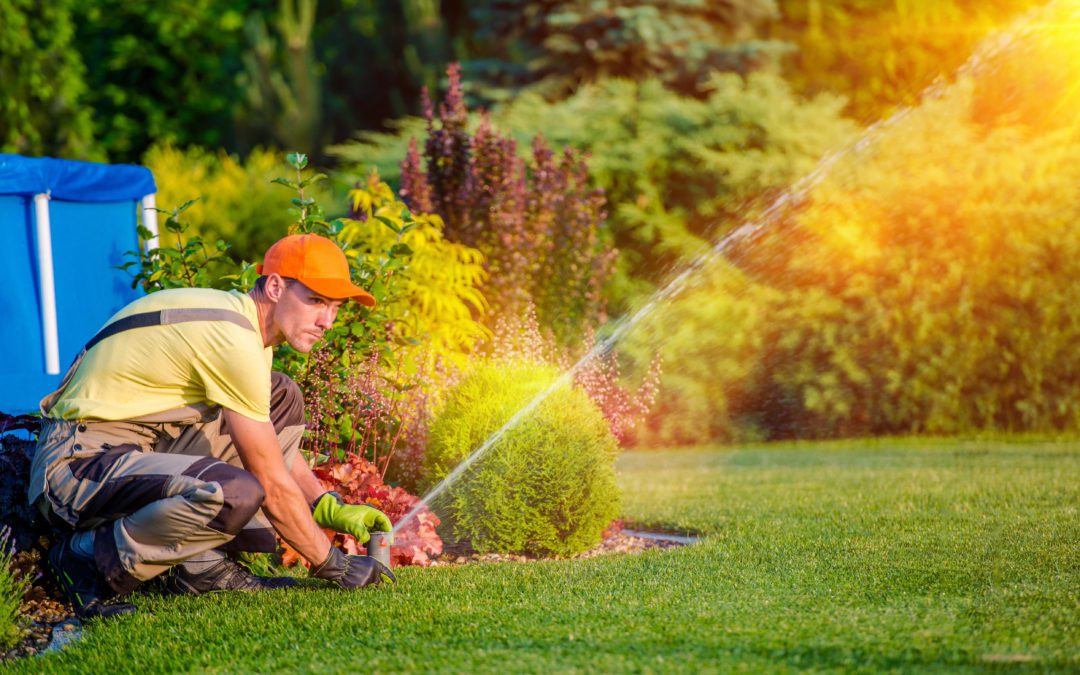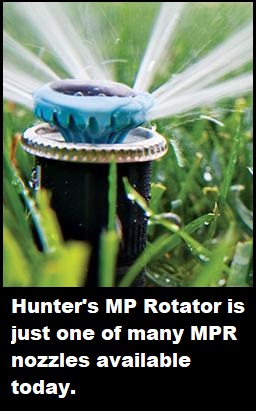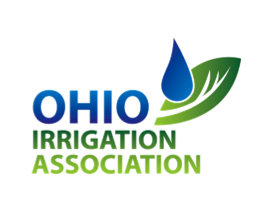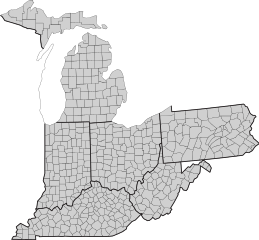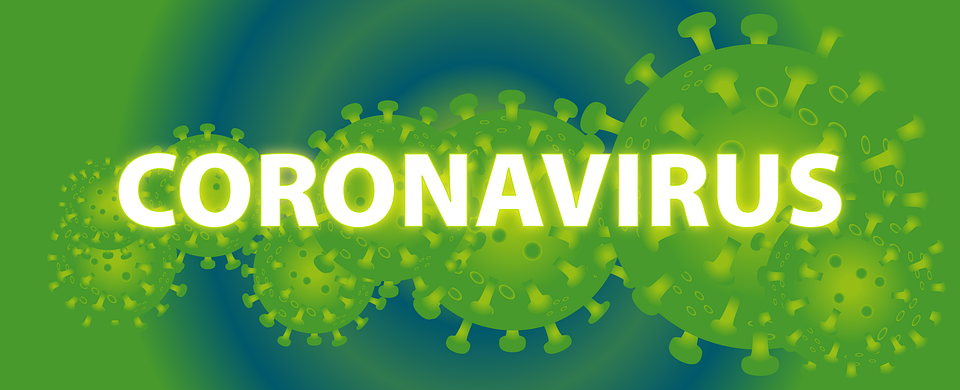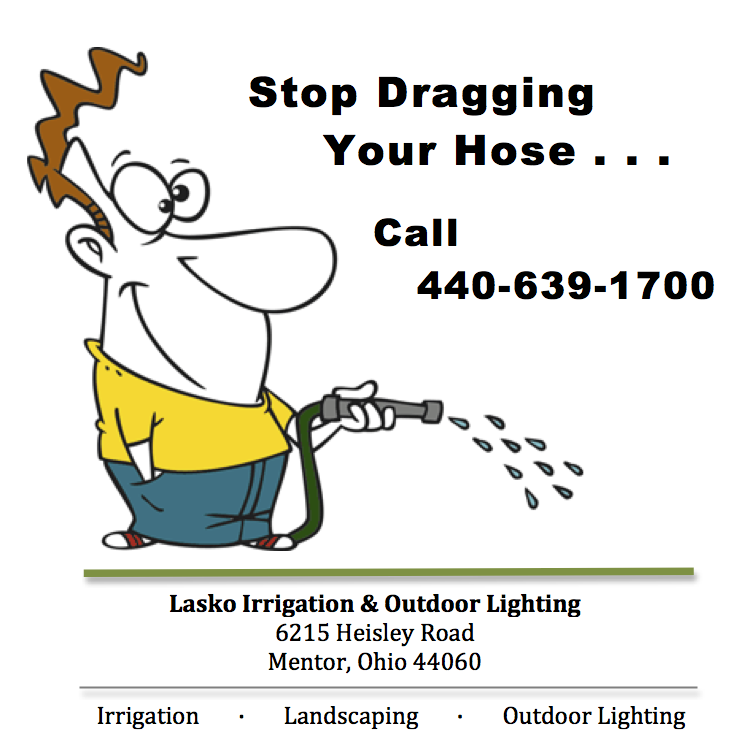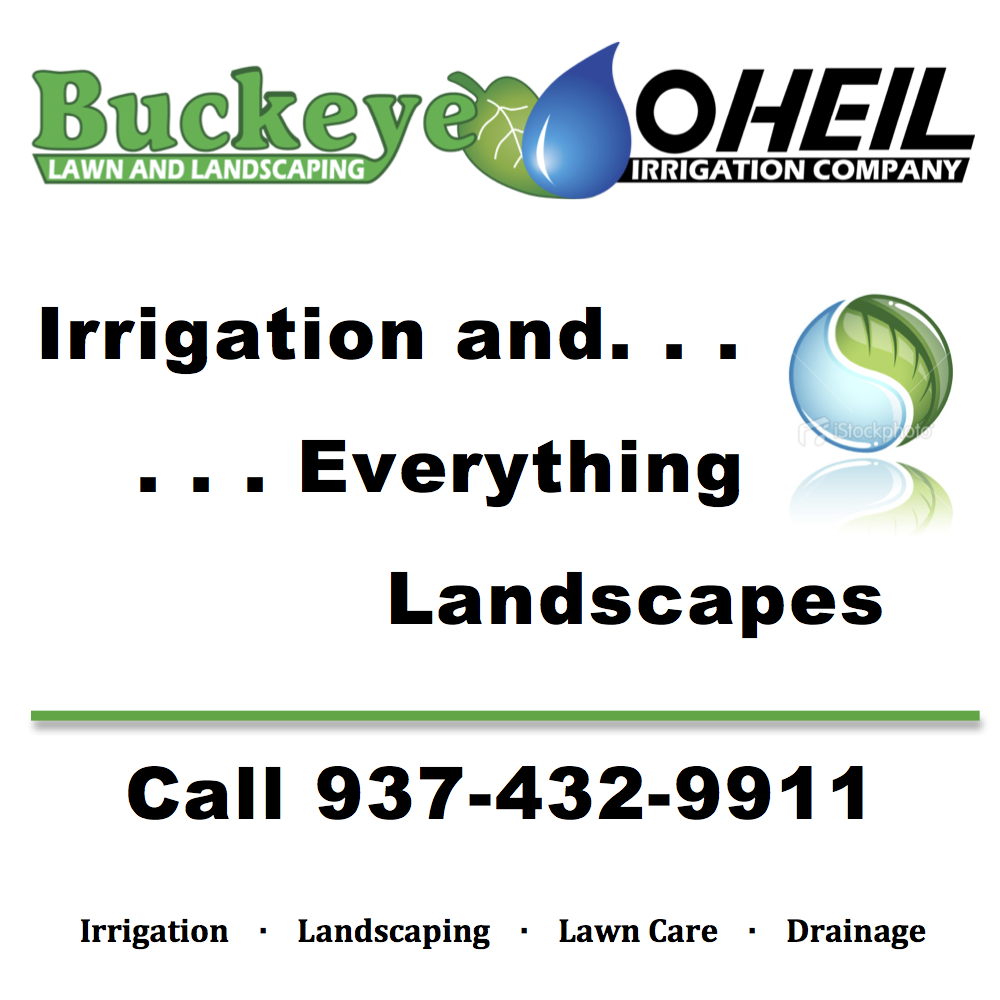
by Tom Barrett | Apr 8, 2020
Matched Precipitation Rates Prevent
Runoff and Dry Spots
As an irrigation professional, you know how important water efficiency has become to the industry.
Gone are the days of sprinkler run-off overflowing into the street. With today’s technology — smart controllers, rotary nozzles, soil moisture sensors, etc. — the irrigation industry is using water much more efficiently than ever before.
And one key to that water efficiency is matched precipitation.
The Basics
When designing sprinkler systems, matching precipitation rates can help to avoid wet and dry spots, as well as excessive run times. Which is why irrigation system designers must consider flow rates and arcs of coverage to ensure even precipitation for each coverage area or zone.
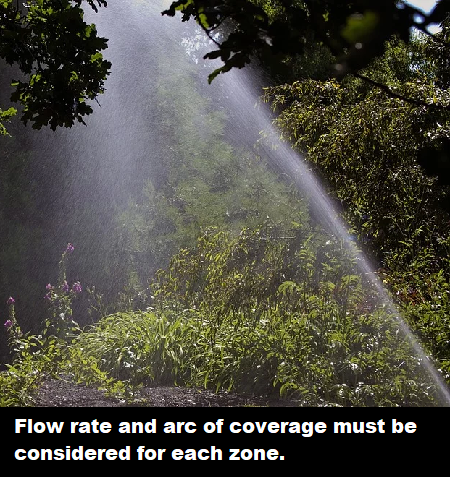
Pixabay Image
Flow rates are proportional to the degree of arc covered. For example, the flow rate of a quarter-circle (90⁰) sprinkler head is equal to one-quarter that of a full-circle (360⁰) head. Likewise, the flow rate of a half-circle (180⁰) spray is equal to one-half that of a full circle.
Matched precipitation rate can be achieved two ways:
- By zoning together sprinklers with the same precipitation rate (Gallons Per Minute x 96.3 ÷ area), or
- By selecting the appropriate Matched Precipitation Rate (MPR) nozzles.
Note: Spray and multi-stream rotary heads automatically match precipitation; single-stream rotors do not.
Zoning Together
When heads without matched precipitation rates are used in the same zone, dry spots often develop. This can lead to the extension of sprinkler run times, as the entire area is watered longer to keep the dry spot alive. That’s why it’s important to always zone together sprinkler heads with the same precipitation rate.
This can be achieved by matching the gallons per minute (GPM) of a standard rotor to its arc and reducing the range accordingly. For example, two GPM at 90⁰ would equal four GPM at 180⁰, or eight GPM if the sprinkler head covers a full circle.
An Illustration
The Hunter Industries website offers the following illustration of three different sprinkler heads with matched precipitation rates:

Hunter Industries Image
For each of these sprinkler heads, one GPM is applied to each quarter circle (assuming the throw radius is the same for each head). As a result, precipitation is matched.
On the other hand, if you were to install nozzles with the same flow rate on all three heads, areas covered by the 90⁰ head would receive four times as much water as the area covered by the full-circle head. So the quarter-circle area would flood long before areas covered by the 360⁰ head received sufficient water.
(For detailed examples of how this works, click here.)
MPR Nozzles

Hunter Industries Photo
Matched Precipitation Rate (MPR) nozzles provide a much simpler way to match precipitation rates within the respective irrigation zones. These nozzles allow sprinklers with various arcs and radii to be mixed on the same circuit. They work well, for example, with beds or turf areas that are irregularly shaped and therefore require varying radii of sprinkler heads within the same zone.
MPR nozzles offer irrigation contractors and technicians greater flexibility when working on the system. Different nozzles can be used for precise watering, while still maintaining matched precipitation rates across the irrigation zone.
Can You Mix and Still Match?
So can different types of sprinklers be used within the same zones? According to Brent Barkley, product manager for Rain Bird in Azusa, Calif., the answer is “Yes, but cautiously.”
“With careful design, and the right products, it is possible to match the precipitation rates of rotors and rotary nozzles, allowing them to be zoned together while irrigating different sections of an irregularly shaped lawn,” said Barkley. An example would be if rotors are being used on a fairly large area of turf in a front lawn, you could probably utilize some rotary nozzles to irrigate a narrow strip of side yard.
What you want to avoid, however, is a hodgepodge (“crazy quilt”) of sprinkler types with no apparent rhyme or reason. A situation like that can result when numerous repairs and alterations are performed by various contractors over the years.
Particularly on older systems, you may see the crazy quilt layout, with a combination of spray heads and rotors delivering water at much different precipitation rates. In such a situation, replacing the spray heads with rotary nozzles can help come very close to achieving matched precipitation rates without replacing the whole system.
Sources:
Featured Image: Adobe, License Granted
Hunter Industries
Irrigation & Green Industry
Irrigation Toolbox

by Tom Barrett | Apr 5, 2020
A Discussion on CARES Act Loans,
Grants and Business Relief
Last week AmericanHort hosted a webinar titled, “A Discussion on the Coronavirus Aid, Relief, and Economic Security (CARES) Act — Loans, Grants and Business Relief.”
Two representatives from K·Coe Isom, Senior Associate Kala Jenkins and Federal Affairs Lead Brian Kuehl, led the discussion. Here’s a copy of the webinar and below is a summary of the presentation:

A Discussion on the CARES Act–Loans, Grants, and Business Relief
Key Provisions of CARES Act
The CARES Act became law on Friday, March 27, 2020. Everything is subject to change. The Act includes three stimulus bills:
- Phase 1: $8.3 million; economic injury disaster loan
- Phase 2: Families First response act (tax credits and labor issues)
- Phase 3: $2 trillion stimulus
- Paycheck Protection $349 billion; over an 8-week period (could become oversubscribed)
- Economic Injury Disaster Loans (EIDLs) $10 billion for
- $500 billion for economic stabilization
- $9.5 billion for agriculture; unclear how it will be used (green industries could be considered “specialty crops”)
- $14 billion for commodity credit corporation (payments for trade disruptions)
Paycheck Protection
Eligibility:
- Applies to small business, generally under 500 full-time and part-time employees
- Must certify that business has been impacted by COVID-19
- Funds must be used for payroll, mortgage or lease, and utilities—all incurred before February 15, 2020.
Loan Amount
Based on monthly average payroll for last year X 2.5 OR $10 million, whichever is less.
How to Define Payroll Costs
- Wages, salaries, commissions, tips (with $100,000 cap per employee)
- Employee benefits (vacation, sick leave, insurance, etc.)
- State and local income taxes
- Also applies to sole proprietor or independent contractor
Loan Forgiveness
- Must track payroll, mortgage interest or lease, and utilities during 8-week cover period
- After 8 weeks, apply for debt forgiveness from lender
- Debt forgiveness excluded from gross income
- Expect 75% of funds will be for payroll
- Must keep track of full-time monthly average of employees. Forgiveness amount can be reduced if 8-week cover period shows fewer employees compared to previous year, or if there’s been more than 25% reduction in salary and wages, unless employees rehired or salaries restored by June 30.
- Funds that are not forgiven termed out after two years with max. interest of 0.5%, payment deferred for 6 months
- Waiving: normal loan fees, denial of credit letter, personal guarantee, collateral
When to Apply
- Small business and sole proprietorships can apply April 3, 2020.
- Independent contractors and self-employed can apply April 10, 2020.
Other lenders may also be approved through SBA.
Economic Injury Disaster Loan (EIDL)
For businesses with working capital loss or revenue loss.
Eligibility: Businesses (includes sole proprietors, independent contractors, ESOPs and cooperatives) with no more than 500 employees (and small agricultural companies)
What It Covers:
- Repaying obligations that can’t be met
- Meeting increased costs due to demand
- Rent or mortgage
- Payroll
- Sick leave for COVID-19 victims
(EIDL can be used together with PIP loan, but cannot be used to cover the same expenses, such as payroll.)
Maximum loan amount = $2 million; amount of loan determined case by case.
Interest rate: 3.75% for small business; 2.75% for non-profit; maximum 30-year payback period.
Waiving: personal guarantee for loans less than $200,000; one-year in business requirement; denial of credit letter.
EIDL is not eligible for debt forgiveness, except for $10,000 maximum emergency grant for payroll protection.
QUESTIONS
How can existing loans be refinanced through PPP loan program?
SBA loans only may be refinanced depending on type of loan and date of closing.
How is 500 employee threshold determined?
- Businesses of 500 or fewer full-time and/or part-time employees
- Businesses of more than 500 full-time and/or part-time employees with certain NAICS code available on SBA website.
- Provisions for seasonal staff: Avg monthly payroll is for 12-week period beginning 2/15/19 and ending 6/30/19.
What about affiliates? Should they be treated as a single entity when applying?
Affiliation requirements are waived for some classes of businesses. Would depend on how business is structured.
Important to step back and take a diagnostic assessment of all business program before applying, as you may not be eligible for other programs. Develop a strategy.
Can funds be used to pay H2A contracted workers?
Cannot apply payroll funds toward labor contractor. H2A workers are considered to be living outside the U.S. and not eligible.
Can businesses take the loan and forego forgiveness?
Yes, but you still must abide by loan eligibility requirements.
by Tom Barrett | Mar 30, 2020
Board of Directors Meeting
March 27, 2020
MEETING AGENDA:
Type of Meeting: Teleconference
Call to Order by President
ORDER OF BUSINESS
I. Roll Call –
-
- Tom Barrett
- JC Wheaton
- Joe Twardzik
- John Dolle
- Jerrad Lee
- Kris Keckley
- Perry Bruggeman
- John Newlin
II. Presidents Report: Jerrad Lee
-
- Talked about IA Legislative Fly in.
- *H2B
- Tax credit for installing Smart Irrigation Technology
- Communication
- Social Media
- Linked In & Face book (Jerrad to take care of)
III. Tom Barrett Report
-
- Economic Response by Federal Government
- SBA Loans vs. Grant Money
IV. Goals : Jerrad Lee
-
- Education: using IA education materials
- National IA become a chapter?
- What this means is they do administrative work for a fee
- Membership increase numbers
- Become a part of OIA or ONLA?
- Have an Advocate for the state of Ohio communicate with IA
V. Adjournment

by Tom Barrett | Mar 27, 2020
How Will the Coronavirus Affect the Landscape Irrigation Industry?
In an effort to stem the coronavirus pandemic, the Ohio Department of Health has issued a Stay at Home Order for all non-essential businesses across the state. Landscape irrigation contractors are wondering where they fit in.
Of course, agricultural irrigation is considered an essential function because of its role in necessary food production. But is landscape irrigation considered “essential” or “non-essential”?
Bad Timing
While there’s never a good time for a pandemic, early spring is particularly problematic for green industries. This six-to-eight-week period is peak season. For irrigation contractors, it’s time for spring tune-ups, inspections and backflow testing.
In an open letter to legislators and other officials, available on the national Irrigation Association website, the IA states:
“We are entering the spring months when many irrigation systems will be turned on by the homeowner/property manager. It is imperative that these systems are professionally inspected (in accordance with state and local codes and regulations), ensuring there are no leaks and the backflow prevention device is operating properly.”
The association further argues that landscape irrigation should be included in essential services because:
“We need to ensure water is available for all uses during this health emergency. Ensuring irrigation systems are doing their job and running properly is an essential component in protecting our nation’s water supply.”
CISA’s Essential Critical Infrastructure Workforce
There are two separate categories where landscape irrigation professionals could be considered part of the Essential Critical Infrastructure Workforce, according to Homeland Security’s CISA List:
- Water and Wastewater. “Workers repairing water and wastewater conveyances and performing required sampling or monitoring.” (e.g., backflow testing), and
- Public Works. “Workers such as plumbers, electricians, exterminators, and other service providers who provide services that are necessary to maintaining the safety, sanitation, and essential operation of residences.”
The argument could also be made that, since irrigation professionals perform virtually all of their work outdoors, close human contact can easily be avoided.
Economic Outlook for Irrigation

Construction
Guidelines
As of March 31, here are the pandemic guidelines for the construction industry for Ohio and neighboring states.
(Please note: Guidelines continue to change. Check with your local authorities.)
Ohio: Construction on critical infrastructure continuing
Pennsylvania: All construction halted
Indiana: Critical construction continuing
Kentucky: Construction and landscaping considered essential
Michigan: Construction on critical infrastructure continuing
West Virginia: Critical construction continuing
According to chief economist Dr. Charlie Hall, before this pandemic, the green industry was poised to have a very good spring. Since the outbreak, there have been supply chain disruptions, massive unemployment, quarantines, closures and negative demand shocks.
The question now is: “Will consumers continue to spend their money in the lawn and garden area?” Currently, it’s impossible to tell.
Dr. Hall outlined four possible outcomes for the current economic recession:
- The medical and economic crisis ends in three months and businesses gradually return to some sense of normalcy.
- The pandemic is seasonal – decreasing with warm weather and returning in the fall – in which case the economic downturn would last 12 months.
- The pandemic / economic downturn persists until “herd immunity” is reached, in about two years.
- The pandemic / economic downturn persists until a vaccine or treatment is developed, in about 12-18 months.
What to Expect
Dr. Hall also suggested that green business owners can expect “clusters” of illness among their team members. So it’s important to identify susceptible critical functions, as well as supply chain risks.
Some irrigation contractors may be eligible for federal loans or other benefits. In order to receive them, you’ll have to measure and document the economic impacts of the coronavirus pandemic on your business. Hall also said that this is not the time to be making any big business decisions. Defer those until the crisis has passed.
Growth Opportunities?
The good news is…being ordered to stay at home, people will certainly be spending more time in their yards and gardens. Which means they’ll want to keep their landscapes green and healthy.
Resourceful business owners will use this opportunity to spread the word about the many health benefits of plants. The Texas A & M Extension offers an extensive list of publications and websites which tout the benefits of plants on human health and well-being.
For more information about the effect of the coronavirus on the green industry, check out AmericanHort’s Coronavirus Resource Center.
Sources:
Featured Image: Pixabay
Cleveland Scene
Irrigation Association
CISA
AmericanHort

by Tom Barrett | Mar 26, 2020
ONLA Offers Best Practices for Contractors During Pandemic
The Ohio Nursery and Landscape Association (ONLA) advises landscape irrigation contractors to use careful discretion in determining whether they remain operational during the coronavirus pandemic.
In its COVID-19 update the association stated:
“The ultimate decision and responsibility rests with the business owner, and should be made in the context of strict adherence to health and safety guidance to protect workers and customers.”
Best Practices

Do You Have a
Garden Center?
Does your business include a garden center?
As the weather warms up, people staying at home will be looking for supplies to maintain their lawns and gardens.
Check out the ONLA website for best practices to follow while operating garden centers during the pandemic.
For those contractors who choose to continue operations, the ONLA offers the following best management practices:
- Obtain permission from clients prior to service – preferably, in a documented format such as email or other electronic communication.
- Implement daily communications to all staff in order to educate and reinforce protocols.
- Relax attendance policies to allow any employee to stay home and use PTO.
- Train crew members to respond to questions from the public in a professional manner.
- Enforce cleaning and sanitation protocols for all common spaces, including trucks and equipment.
- Stagger crew start times to minimize personal contact.
- Limit crews to one person per truck, while all other crew members drive directly to the jobsite.
- Divide crew size into smaller, isolatable segments.
- Assign one truck per crew and do not rotate.
- Minimize use of shared equipment and tools.
- Direct crew members to wear gloves as much as possible.
- Direct crew members who must work in close proximity to one another for a short period of time to wear a face mask.
- Be prepared to shut down a project any time, if the customer raises health or safety concerns.
Sources:
Featured Image: Pixabay
ONLA
